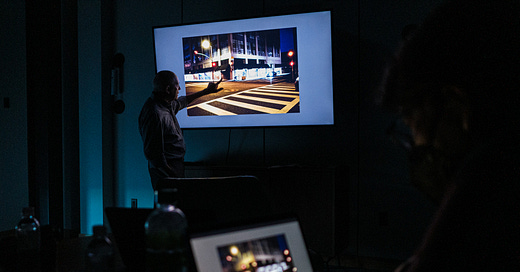I began the year attending a photography workshop with Sam Abell, a former National Geographic photographer. It was a wonderful way to start the year, sitting at the feet of a photographer whose work has inspired me for decades and whose philosophy shaped my relationship with photography.
I didn’t learn new things that weekend. It was a renewal, a reaffirmation of a photographic sensibility I had learned by looking at Sam's work and repeatedly reading his books, including Sam Abell: The Photographic Life, Stay This Moment, and The Life of a Photograph. I returned to those books at various periods of my creative life, experiencing a new epiphany sparked by experience and age.
Years before I met him, Sam was the first to suggest that photography was more than an occupation or a craft. It wasn’t a collection of equipment and an accumulation of technical skills. That might suffice, and it does for many, but he suggested that something richer and more fulfilling existed.
Relationship. That is not the word he used, but it is the heart of the creative philosophy he has practiced and shared for decades. Making photographs is a relationship between the photographer and the world around them and, even more poignantly, between the photographer and themselves. It’s a communion that comes into existence within the clean, rectangular frame of the camera’s viewfinder. It is a way of seeing and being that Sam learned from his father.
“Compose the picture, Samy, and wait.” That instruction was rich in meaning. It spoke of composition and the relationship between fixed elements within the scene. It was also about the importance of choice, of what to include or exclude from the frame. It also encouraged Sam to be sensitive to the unexpected synchronicity of beauty, gesture, and form that can only be discovered through practicing patience.
It is an understatement to say that Sam’s father taught him composition. He planted the seeds of a way of seeing and experiencing a moment. It nurtured a sensitivity always present in Sam, whether he was standing on a train station platform waiting for an incoming train or on a quiet Japanese street in Hagi City, witnessing two middle-aged women bid farewell to each other.
I saw it for myself as I watched Sam standing in front of the Los Angeles Flower Market entrance on a chilly Saturday morning. He stood a few feet away from the driveway that led into the market’s interior. I saw as Sam analyzed the scene's potential, parsing its various exterior and interior elements: cardboard boxes, fluorescent lighting, a small table, a chair, and the occasional movement of people. Like a monk immersed in deep meditation, he stood there, peacefully still, and waited.
I don’t know what he saw through his viewfinder. I didn’t ask to see the photograph he had taken, nor did I need to. I didn’t need the picture to validate or prove a creative approach.
Instead, what I saw and needed to see was myself and the countless times I had done the same. At that moment, I shared a kinship with him. It was kinship born of understanding a scene's potential for beauty and awe and the privilege we are given to recognize and memorialize it in a photograph.
I didn’t attend the workshop because I wanted to learn how to photograph like Sam Abell. We each had ways of seeing and making different choices regarding how we shaped the world in our viewfinders. However, we shared an appreciation for the gift that photography has provided us.
“Understanding what you like is understanding who you are,” he said.
As Sam has demonstrated countless times with his photographs, those moments of self-discovery can be a gift to oneself and the world. All it takes is the willingness to see, compose, and wait.
Breaking Out of a Rut Webinar
I am conducting a webinar through the Los Angeles Center of Photography on April 27th. Breaking Out of a Rut: Tips for Creating Breakthroughs in Your Photography is a 90-minute presentation in which I discuss what it means to be in a creative “rut” and the steps I use to understand and navigate such times. I have repeatedly experienced such moments throughout my career and share tools and resources that I have found invaluable to sustain a life of creativity.
Find out more by visiting the LACP website and sign up today.






Great post! Lots to learn.
Very thoughtful piece.
I remember watching a documentary about Sam Abell in which he explained the process he went through that resulted in that famous shot of a window with pears on the sill and the Kremlin in the background. Trial, error, good fortune, and patience all played a part in what became a National Geographic cover.
He commented that the image was later printed elsewhere reversed due to an easy mistake that can happen with analog slides but would be unlikely to happen with a digital image.